When arriving home or to anyone else’s house the first things you usually encounter are driveways. Equally, when leaving it’s also the last thing you see which means it needs to make a good impression.
There are a number of materials you can choose from to create a lasting impression when laying your driveway but most commonly you’ll see concrete, paved, tarmac and gravel surfaces. As you may have noticed, our personal favourite is a gravel driveway so today we’ll be looking in detail at its advantages and disadvantages.
Install Long Lasting and Durable Gravel Driveways
Providing your driveway is laid and maintained correctly, a gravel driveway will last a lifetime.
If you choose to lay inconspicuous gravel driveway grids beneath the gravel you won’t have to worry adding to the gravel layer all too often either because the structure of each grid prevents gravel migration.
How much do gravel driveways cost?
One of the best things about opting for a gravel driveway is that the materials needed are relatively cheap compared to others.
A bag of gravel, for example, is available for under £3 in most hardware stores and is great for a small space. If you’re drive is a little bigger though then it’s always better to buy in bulk, so this £159 bag which covers 12sqm should do the trick.
If you choose to install gravel driveway grids (honestly, you’d be mad not to) then expect to pay between £9.99 – £15 per square metre depending on scales and also the colour you choose – you have a choice of black, green or white.
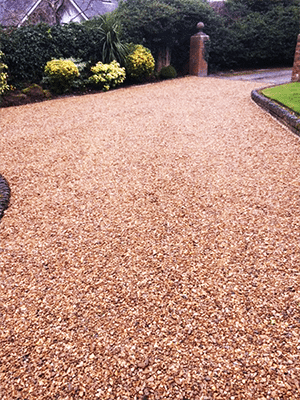
The Aesthetics of permeable gravel driveways
To prevent weeds from appearing in the middle of your beautiful driveways, you should also consider laying a protection weed membrane underneath the gravel pavers. These membranes are available in a number of sizes to suit any sized driveway, but just in case we can’t fit yours perfectly, they’re really easy to cut and fix together too. The cheapest of our landscape membranes is a roll of 1m x 12m available from £6; the largest roll we currently have available is 500m² at a cost of £240.
That’s the practical elements out of the way, so what about the way it looks? The truth is, given its natural tones, gravel looks great on any driveway, modern or traditional. However, if the exterior or your home is warm – say, red-brick or wood – or even a neutral colour, the gravel will pop even more!
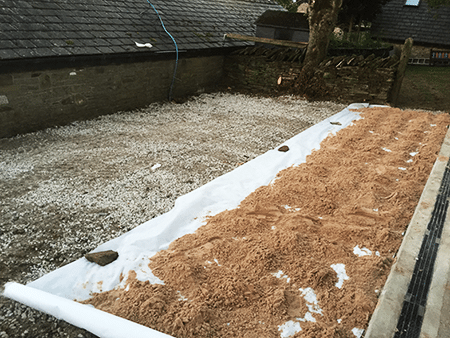
Advantages
There are so many advantages it’s hard to fit them all into one post, but we promised, so here goes…
Budget – Gravel is so easy on the budget, especially if you’re covering a large area and you’ll find that outfitting a large driveway with gravel is much cheaper than any other material. The only thing to account for monetary-wise after then initial laying of the drive is a top-lay every few years, although the need for this will also be minimised if you choose to install gravel pavers to prevent migration.
Maintenance – The only maintenance required with a gravel driveway is the removal of weeds – if you decide not to lay a weed prevention membrane – and the top-up of gravel every few years. The best part is, you don’t need any specialist equipment, just a shovel and a rake and you’re good to go.
Style – Gravel is natural and therefore suits many different styles of home unlike concrete or tarmac which can look extremely out of place, especially if your house is old and traditional.
Permeable – One thing many people don’t realise about a gravel drive is that, when installed properly, natural drainage routes are maintained which means groundwater is replenished and the chance of flooding is therefore minimised. Gravel paving grids also help with this as their cellular structure is intended to hold gravel tightly while still allowing natural water flow.
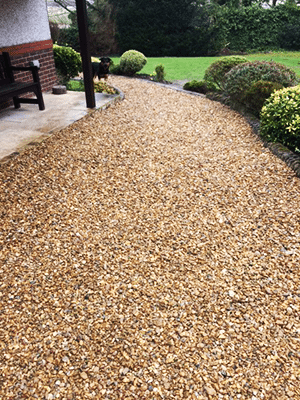
Disadvantages
Unfortunately, everything comes with a downside, luckily for gravel though it’s only a few.
Snow – Certain parts of the UK will have to deal with the woes of snow every now and again and removing snow from a bumpy surface admittedly can be a hassle. However, when you think that if you choose to use gravel grids, the snow is really the only downfall it’s not all that bad, is it?
Ruts and holes – Without some form of stabilisation like gravel grids or a similar alternative, gravel will shift over time causing grooves, ruts and mounds where water can collect, it becomes difficult to walk and is a nuisance to drive on. Now luckily, gravel can easily be levelled either by raking what’s already there or adding a new layer. However, it can easily be prevented, take a look at the great, migration-free driveway created by Jan and Christine at the Little House on the Corner.
That’s pretty much it, there really isn’t much that can go wrong with gravel. Let us know your gravel driveway stories by getting in touch on our Facebook page.
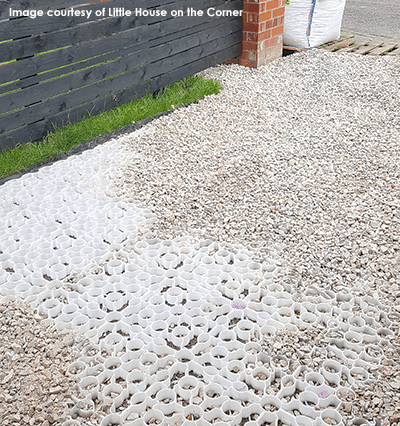




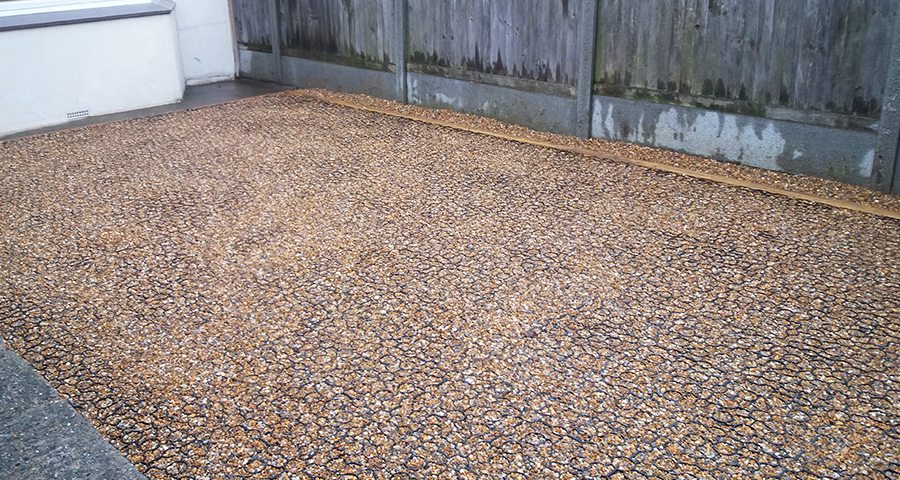
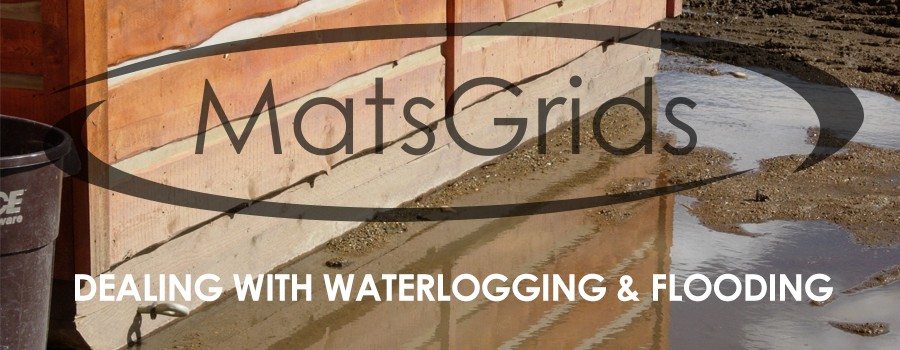
Great article about pros and cons of gravel driveways. Of course the driveway is first to see and and last to when visit a home or office. So if we want to make a good first impression we do have to keep our driveway neat and clean. So this article about gravel driveway pros and cons going to be a lot of help for future readers. Thanks for sharing with us. Keep these coming. Cheers.
Hi guys I have 120m2 of concrete drive and want to know if your product can go straight on top?
Hi Glen, Thanks for your comment. Take a look at our X-Grid Installation Guide for details on how it can be installed: https://www.matsgrids.co.uk/wp-content/uploads/2021/02/X-Grid-Tech-Install-Guide-12.pdf
Hi, could I use the grid system with a membrane to create a more stable layer that may be less prone to sinking on clay soil, before laying block paving on top? Every drive that has been laid in the last 5years in my neighbourhood has sunk requiring blocks to be lifted and back-filled with sand or concrete.
I was looking to compact 6inches of sublayer with heavy duty 85kg compactor, before applying the grids. Then fill the grids with a combination of MOT and my old stone chippings, before levelling with sand and finally finishing off with blocks.
Hi,
Thank you for your comment. It would be better if we could speak over the phone in more detail. Could you give us a call on 01246 589092 and speak to a member of our sales team.
Look forward to hearing from you.
Are the grids visible after a few months, as our driveway installer advised?
Hi Ray,
If you have a minimal overfill of around 20mm and use angular gravel, this will reduce the amount of grid visibility. It may require very infrequent gravel redistribution but our grids are are designed to prevent migration and will not rut like loose gravel.
We hope this helps, if you have any questions please do not hesitate to contact us.
Hi, What’s the maximum practical slope your grids can be used on?
Thanks
Hi Dave,
Thank you for your comment. The maximum gradient X-Grid can be used on is 12 percent.
Thanks,
Would it be possible to use the grids with a resin system ?
I was looking at mixing the gravel with the resin then filling in the grid and then smoothing out with a trowel.
Regards
Mike
Hi Mike,
Thanks for your comment. Yes this is possible and has been done before many times. This is a previous example of X-Grid used with resin bound.
Hope this helps.
Hi, would I be able to use 20mm shingle on top of this product?
Hi Rhys,
Thank you for your comment. Yes you would be able to, we recommend using gravel/shingle up to 20mm in diameter.
Hope this helps.
Hi. What depth of loose 20mm stone is needed to fill the grid and overflow so the grid can’t be seen?
Hi Jenny,
We estimate that around 8kg of gravel is required to fill one individual X-Grid panel.
Hope this helps.
Hi could someone give me a quote please for my driveway
Hi Joanne,
Thanks for your comment. We are more than happy to quote you for X-Grid to help create a gravel driveway but we do not install driveways.
Please could you call us on 01246 589092 to speak with a member of our team who will be able to assist.